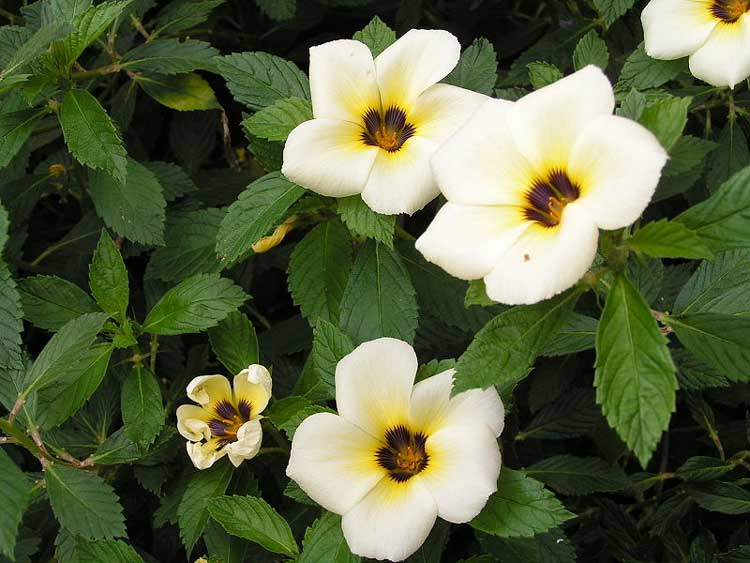
Turnera subulata (*)
Classification System: APG IV
Superregnum: Eukaryota
Regnum: Plantae
Cladus: Angiosperms
Cladus: Eudicots
Cladus: Core eudicots
Cladus: Rosids
Cladus: Eurosids I
Ordo: Malpighiales
Familia: Passifloraceae
Subfamilia: Turneroideae
Genus: Turnera
Series: T. ser. Turnera
Subseries: T. subser. Turnera
Species: Turnera subulata
Name
Turnera subulata Sm., Cycl. 36: n. 2. 1817.
Synonyms
Heterotypic
Turnera elegans Otto ex Nees, Horae Phys. Berol. 36. 1820.
Turnera mollis Kunth, Nov. Gen. Sp. (H.B.K.) 6. 126. 1823.
Turnera peruviana Willd. ex Schult., Syst. Veg., ed. 15 bis (Roemer & Schultes) 6: 679. 1820.
Turnera sericea Kunth, Nov. Gen. Sp. (H.B.K.) 6. 127. 1823.
Turnera trioniflora Sims, Bot. Mag. 47: t. 2106. 1819.
Turnera ulmifolia var. elegans (Otto ex Nees) Urb., Jahrb. Königl. Bot. Gart. Berlin 2: 139. 1883.
Turnera virgata Willd. ex Schult., Syst. Veg., ed. 15 bis (Roemer & Schultes) 6: 678. 1820.
References
Tropicos.org. Missouri Botanical Garden. 04 Oct 2009 [1].
Vernacular names
English: White Alder, Politician's Flower, White Butter Cup
Turnera subulata is a species of flowering plant in the passionflower family known by the common names white buttercup, sulphur alder, politician's flower, dark-eyed turnera,[1] and white alder.[1][2] Despite its names, it is not related to the buttercups or the alders. It is native to Central and South America, from Panama south to Brazil. It is well known in many other places as an introduced species, such as Malaysia,, Indonesia, several other Pacific Islands, the Caribbean, and Florida in the United States. It is commonly cultivated as a garden flower.[3]
Growth
This plant is a perennial herb growing from a thick taproot and woody stem base. It reaches a maximum height around 80 cm (31 in). The leaves are roughly oval in shape with toothed edges. The undersides are glandular and coated in white hairs. The upper surfaces may be somewhat hairy, as well. The leaves are up to 9 cm (3.5 in) long. Flowers occur in the leaf axils, borne in calyces of hairy, glandular sepals. The petals are rounded to oval, the longest exceeding 3 cm (1.2 in).[2] They are white or yellowish with darker bases.[1] The dark patches at the bases are nectar guides.[4] The center of the flower is rough, feeling like a cat's tongue.[1] The fruit is a hairy capsule containing seeds with white arils.[2] The seeds are dispersed by ants, who are likely attracted to their high lipid content.[5] The plant is pollinated by a variety of insects, including the bee Protomeliturga turnerae, which is oligolectic, specializing on this plant species and depending completely on it for reproduction. The male bee builds his territory around the plant, for example. Thus, this particular bee is a common pollinator of the flowers. Other insects observed at the plant include many other bee species, such as Trigona spinipes, Frieseomelitta doederleinii, and Plebeia flavocinta, butterflies such as Nisoniades macarius and Urbanus dorantes, and the beetle Pristimerus calcaratus.[4]
Appearance
Like most other Turnera,[4] this species is heterostylous, with two morphs. The "pin" morph has long styles in its flowers, while the "thrum" morph has short styles. Both morphs produce the same amount of pollen. One study reported that during pollination, pin flowers receive more pollen from thrum flowers than from other pin flowers.[6] The genes that cause this dimorphism in style size are the subject of current research. So far, it has been established that short styles contain proteins, polygalacturonases, that are absent in long styles.[7]
Traditional medicine
This section needs more medical references for verification or relies too heavily on primary sources. Please review the contents of the section and add the appropriate references if you can. Unsourced or poorly sourced material may be challenged and removed.
Find sources: "Turnera subulata" – news · newspapers · books · scholar · JSTOR (July 2015)
Rod of Asclepius2.svg
This plant has uses in traditional medicine.[8]
References
Yim, E. What’s up, buttercup? New Straits Times (Malaysia). April 28, 2012.
Turnera subulata. US Forest Service. Pacific Island Ecosystems at Risk (PIER)
"Turnera subulata". Germplasm Resources Information Network (GRIN). Agricultural Research Service (ARS), United States Department of Agriculture (USDA). Retrieved 21 January 2018.
Schlindwein, Clemens; Medeiros, Petrúcio C.R. (2006). "Pollination in Turnera subulata (Turneraceae): Unilateral reproductive dependence of the narrowly oligolectic bee Protomeliturga turnerae (Hymenoptera, Andrenidae)". Flora - Morphology, Distribution, Functional Ecology of Plants. 201 (3): 178–188. doi:10.1016/j.flora.2005.07.002.
Simberloff, D. and M. Rejmanek, Eds. Encyclopedia of Biological Invasions. University of California Press. 2010. pg 589.
Swamy, N. Rama; Bahadur, Bir (1984). "Pollen Flow in Dimorphic Turnera subulata (Turneraceae)". The New Phytologist. 98 (1): 205–209. doi:10.1111/j.1469-8137.1984.tb06109.x. JSTOR 2433990. PMID 29681115.
Athanasiou, A.; Khosravi, D.; Tamari, F.; Shore, J. S. (2003). "Characterization and localization of short-specific polygalacturonase in distylous Turnera subulata (Turneraceae)". American Journal of Botany. 90 (5): 675–682. doi:10.3732/ajb.90.5.675. PMID 21659162.
Barbosa, Danila de Araújo; Silva, Kiriaki Nurit; Agra, Maria de Fátima (2007). "Estudo farmacobotânico comparativo de folhas de Turnera chamaedrifolia Cambess. E Turnera subulata Sm. (Turneraceae)". Revista Brasileira de Farmacognosia. 17 (3): 396–413. doi:10.1590/S0102-695X2007000300016.
Retrieved from "http://en.wikipedia.org/"
All text is available under the terms of the GNU Free Documentation License

